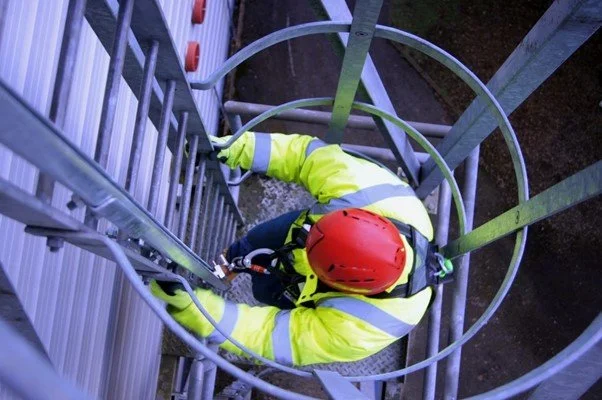Different Kinds of Access Ladders
Access ladders play an essential role in working from height, providing vertical reach for workers to perform work or reach working platforms. According to the UK Health and Safety Executive, the use of ladders can be a “sensible and practical option for low-risk, short-duration tasks”. Ladders are used when equipment offering higher levels of fall protection is not justified due to the low risk or when existing workplace features cannot be altered.At Altus Safety, we offer a range of roof access ladders for various applications. Here’s a look at the ladder systems we have available.
Caged Access Ladders
Caged Access Ladder
Caged access ladders (CAT ladders) are a lightweight and robust solution that can fit any adequate structure. Cages provide basic fall protection for all ladders that measure over two metres in height, and these systems can be used internally and externally in a range of environments.These kinds of access ladders are the primary point of access from ground to rooftops or as conduits from lower to upper roofs. CAT ladders are very versatile and can be integrated into roof edge protection or modified with additional safety measures like wire mesh, safety cages, security doors and exit platforms.
Fall Arrest Ladders
Fall Arrest Ladder
Fall arrest ladders provide a fixed access ladder in the event of accidental falls while ascending or descending. They provide a safe and controlled fall protection system that gives superior protection for vertical climbing. It comprises of either track or a wire-based system that creates either vertical safety lines or a vertical track system.
These ladders allow multiple users on the track at one time. Their innovative system can be clamped or fixed to most structures, such as brickwork, concrete and steel structures. Workers wear a body harness that connects to a shock-absorbing travelling device that runs along the track. Workers glide along the ladder, allowing them to move up and down hands-free without manual adjustment.
Companionway Ladders
Companionway Ladder
Companionway ladders are more practical than vertical ladders and are used to access heights under three metres. They are safer than vertical ladders due to their slope inclined design that provides more stability. They are angled between 65° to 75° and are used when space is at a minimum and insufficient for a staircase.You can integrate a companionway ladder with guardrail edge protection as part of an access strategy. We provide these ladders with a single line of handrail on each side for a safe hold. They are lightweight and available as a freestanding or permanent fixture.
Ladder Ties
Ladder ties are used to provide strong ladder fall protection. Ties and restraints are used with removable access ladders to provide a safe working environment, letting workers work alone for short periods to complete a task that would typically require two people.As well as access ladders for safe working at height, ladder ties are a more cost-effective solution than safety eyebolts. These straps are easily stored and transported, ready to be deployed whenever needed. They are a simple yet effective solution to potentially fatal falls. Ladder ties are typically installed in pairs around a building of no more than two metres high and are used in conjunction with three-metre ratchet straps for quick and easy use.
Using Ladders Safely
Ladder
To ensure safe use of access ladders when needing to access another level, they should be tied and extend at least one metre above the landing point to provide a secure handhold. Always make sure you are never overreaching when on a ladder and that it is the correct height for the task at hand.Never overload ladders, so consider the weight of equipment and materials that need to be carried before working at height. Do not extend ladders while standing on rungs, and do not work off the top three rungs. Ladders should never be stood on moveable objects like pallets, lift trucks, scaffolding or vans. Maintain three points of contact while climbing (two hands and two feet) and ensure you are using an effective stability device if there are any times when you cannot maintain a handhold.
Access Ladders from Altus Safety
At Altus Safely, we can provide you with a comprehensive fall protection system. We work closely with our customers and carry out working at height risk assessments to identify hazards and ensure work is being carried out safely. Our access ladders are available in different designs and finishes, such as stainless steel, aluminium and powder coated. We can provide you with ladders with or without cages or fall arrest systems and retractable bottom sections to prevent unwanted access. Contact us today to learn more about our access ladders or our fall protection design, supply and installation.




